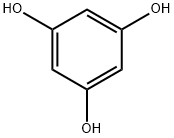Phloroglucinol Anhydrous , ≥99.0%(HPLC) , 108-73-6
Synonym(s):
1,3,5-Trihydroxybenzene;Phloroglucinol
CAS NO.:108-73-6
Empirical Formula: C6H6O3
Molecular Weight: 126.11
MDL number: MFCD00002286
EINECS: 203-611-2
PRODUCT Properties
| Melting point: | 215-220 °C |
| Boiling point: | 194.21°C (rough estimate) |
| Density | 0.801 g/mL at 20 °C |
| bulk density | 560kg/m3 |
| vapor pressure | 0.001Pa at 25℃ |
| refractive index | n |
| Flash point: | 14 °C |
| storage temp. | Store below +30°C. |
| solubility | Soluble in diethyl ether, ethanol and pyridine. |
| form | Crystalline Powder |
| pka | pK1:8.45(0);pK2:8.88(-1) (25°C) |
| color | White to light beige |
| Water Solubility | 11.17g/L(room temperature) |
| Sensitive | Light Sensitive & Hygroscopic |
| Merck | 14,7328 |
| BRN | 1341907 |
| InChIKey | QCDYQQDYXPDABM-UHFFFAOYSA-N |
| LogP | 0.55 at 25℃ |
| CAS DataBase Reference | 108-73-6(CAS DataBase Reference) |
| NIST Chemistry Reference | 1,3,5-Benzenetriol(108-73-6) |
| EPA Substance Registry System | 1,3,5-Benzenetriol (108-73-6) |
Description and Uses
Phloroglucinol is a naturally occurring phenol that exhibits diverse biological activities. Phloroglucinol protects V79-4 Chinese hamster lung fibroblast cells from oxidative stress and inhibits lipid peroxidation by scavenging reactive oxygen species (ROS). It induces apoptosis in HT-29 human colon cancer cells and inhibits metastasis of BT549 and MDA-MB-231 human breast cancer cells. Phloroglucinol protects primary neurons from β-amyloid-induced dendritic spine loss in vitro and shortens the latency to find the platform in a Morris water maze test in an Alzheimer’s disease (AD) mouse model. Phloroglucinol has been used to stain histological plant sections and in the synthesis of numerous natural products. Phloroglucinol slows the frequency and decreases the amplitude of contraction in isolated rabbit and rat intestine at a concentration of 100 and 1 μM, respectively. Formulations containing phloroglucinol have been used as antispasmodics.
Phloroglucinol is mainly used as a coupling agent in printing. It is an active component of Tollen's reagent and Gunzburg reagent used to test pentoses and hydrochloric acid in gastric juice respectively. In analytical chemistry, it is used to study condensed tannins by means of depolymerization. It is also involved in the synthesis of 2,4,6-triamino-1,3,5- trinitrobenzene, trinitrophloroglucinol and pharmaceuticals like flopropione.
Safety
| Symbol(GHS) |  GHS07 |
| Signal word | Warning |
| Hazard statements | H315-H317-H319-H335 |
| Precautionary statements | P261-P264-P271-P280-P302+P352-P305+P351+P338 |
| Hazard Codes | F,Xi |
| Risk Statements | 11-36/37/38-34-43 |
| Safety Statements | 7-16-24/25-45-36/37/39-26-36/37-37/39 |
| RIDADR | UN 1170 3/PG 2 |
| WGK Germany | 2 |
| RTECS | SY1050000 |
| TSCA | Yes |
| HS Code | 29072900 |
| Toxicity | LD50 in mice, rats (g/kg): 4.7, 4.0 i.g. (Cahen) |


